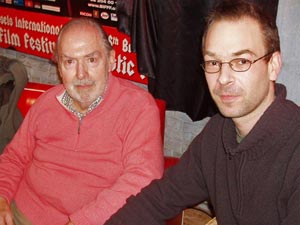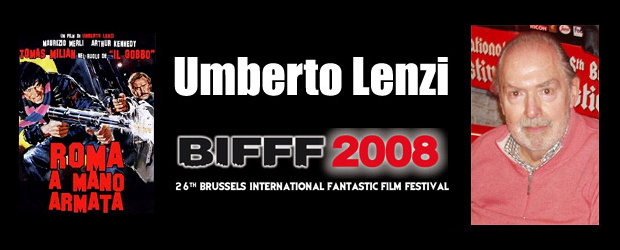Could we talk for a bit about your career…
I started a new career! I made about sixty movies and I’m tired, I’m not so young and I’m going to start another activity. I just finished my first novel – a thriller – named Murder in Cinecittà - Delitti a Cinecittà. It’s a thriller – a polar – about the cinema, about a serial killer acting in the studio.
When is it set?
In the forties, two months before Mussolini declared war on France and England – from January until June 1940 – a very strong story.
A few years ago there was talk about you making an episode for Italian Masters of Horror, for television.
Yes – but that project is over because they had no money. The government changed and they got no more money – it’s a strange story.
Becoming a writer – seems a bit of a drastic career move.
It’s my first novel, but I was already the writer of another book – a book of crime tales.
You wrote some of the scripts of your movies yourself.
Five or ten are mine. Most of the time I wrote the scripts with the screenwriter.
Did you work with them on the script before the movie, or did you change things while you were shooting?
No – my way of making motion pictures is first to write the script very well – alone or with another writer – and to shoot that without changing. Only some lines, when an actor – an American actor – had problems with the translation. But I don’t change during the shooting and nobody can change the movie during editing because – when I shoot I shoot as if I’m already editing. In my movies there is only one way of editing. It’s a good way of shooting because the producer – many times they want to change for commercial reasons and it’s very difficult with my films.
Because there’s no material for them to work with.
Look – Sergio Leone – he was a director who shot many miles of film, from all angles, to do the job without mistake – but one editor can change.
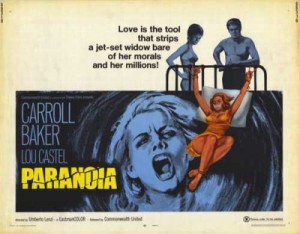 Can we talk about your movie career – starting with Orgasmo? You made films in many different genres before making Orgasmo but it was a big international success.
Can we talk about your movie career – starting with Orgasmo? You made films in many different genres before making Orgasmo but it was a big international success.
Ah! For me Orgasmo is one of the best of my movies, and I’m very happy because next week for the first time the movie will be on Italian online television, and I think after two months it will be out on dvd.
This will probably be only for the Italian market – without English subtitles.
No – only Italian. It’s strange because Orgasmo had as the first title ‘Paranoia’ – when I wrote the script with Ugo Moretti and Marie-Claire Solleville. I liked that title – we shot it as ‘Paranoia’, not only in the script but also on the clapperboard. But they changed it – when I was in Spain, shooting another movie with Jack Palance. The Italian producer changed the title because the distributor said (thinking) “Paranoia”…”Paranoia”..”Noia” – and ‘noia’ is a bad word in Italian – it means ‘boredom’, so they changed the title.
But in America they used the original title.
In America they said “Paranoia is a very good title” and it was an important hit – one of the biggest hits in the history of Italian motion pictures.
Was it a big success in Italy?
In the States it was a very big success, in Italy too. And Paramount – because Carroll Baker was contracted with them – produced another two movies. The second was called Paranoia in Italy (laughs), because the Italian producers thought the first one was a big hit in America as Paranoia. In America it was called A Quiet Place to Kill. The third one was Così dolce… Così perversa with Carroll Baker and Jean-Louis Trintignant – it was shot in Paris in ’69.
Was Orgasmo inspired by a book or another film?
Orgasmo was my original plot.
I’ve always wondered why Carroll Baker’s character has an aversion to television sets in Orgasmo.
Because she is depressed, unstable, anxious… and tries to get her privacy at all costs. Don’t forget that the original title of the movie was ‘Paranoia’.
After the three Carroll Baker-movies you made Oasis of Fear with Ray Lovelock and Ornella Muti.
Ah – yes. I dislike that film.
I like it.
We had problems. Ornella Muti was very young and she could not do the erotic scenes. The other actress – I started with another actress but the last moment, one day before we started, she disappeared. She was an important American actress and opera singer called Anna Moffo – she was famous in the sixties. I had a contract to start, so I had to change and I get the Greek star and she’s not the real character. Irene Papas, she’s a very good actress to play Phaedra, but not the American wife of a diplomat. The movie is strange because the erotic part is a flop and the tension is so-so.
What made you decide to do it almost as a remake of Orgasmo? It’s very similar – some plot elements go different ways, but…
(reluctant)…Yes, maybe there are similarities, but my idea was to do a movie like…like the famous American movie on the motorcycle with Peter Fonda…
Easy Rider.
Yes – they travel, with auto stop, but the part that was difficult was the drugs. Carlo Ponti – the producer – he didn’t want to do it, because they were too young. So we changed it to the porno pictures and magazines. It was stupid because after two years drugs were normal in a picture. You understand? The producer had many problems with the law at the moment. It’s not a good movie because my ideas about ’68, about the young, about the change…I tried to do Italian Easy Rider.
Your gialli were more in the old tradition. Did you like the way the genre changed after Dario Argento’s Bird with the Crystal Plumage?
I liked them – Dario Argento is a close friend, he worked with me as a script writer and was on the set of Orgasmo. Look – my gialli with Carroll Baker and another movie named Spasmo, they were another way of shooting because the main theme is psychosis, eroticism and crypticism in a corrupted world – no Dario Argento-system. Only Seven Bloodstained Orchids, but it’s different because in the movie of Dario, the criminal is masked but in my movie he was a priest, in normal dress, because a priest always wears black dresses (laughs).
Yes – but you’ve got the graphic murders, the killer’s point-of-view shots…
Dario is not the first one – the first one is Hitchcock – Psycho. If you put a camera during the killing…many times it’s important to see the murderer, to see the criminal’s face, but in other cases you only have to do the knife. But often it’s the opposite – the last movie I made starring Carroll Baker, Knife of Ice, it’s important because it was the opposite in doing the crime scenes. It was a remake of The Spiral Staircase – the famous American movie.
It had a strong gothic atmosphere.
Yes – but the victim is the murderer – the same person.
How did you work while writing the script for your Argento-style gialli? Did you first create the spectacle of the murder set-pieces and worked from there – or did you first create the mystery plot surrounding the identity of the killer?
Absolutely not. For me the characters were more important than the murders.
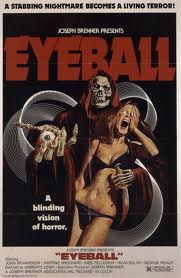 What can you tell about Eyeball?
What can you tell about Eyeball?
Ah – Eyeball, yes. We shot it in Barcelona. It’s a film like an Argento-movie but the climax is different. It’s touristic, not ‘thriller-touristic’, but ‘strange-touristic’.
Some parts of it seem like a travelogue, like promotion for Barcelona, was this part of the Spanish production deal?
It was a very small production, we only had very little money. It was forty years ago, I do not remember. I’m surprised people still remember the movie.
Why did you let the killer wear red gloves?
Maybe the production man only had red gloves (laughs). It’s not important. It’s a weird story with a tourist group in a very beautiful situation – on the Ramblas – with a serial killer inside the group. But I had no money – it was very hard – very hard.
It plays almost like a parody of the genre. It’s a late movie in the period and there’s so many false clues…
Yes – but if you look at this movie in comparison to the others, you see the idea is the same – the psychological, psychiatric alteration of the mind – because Martine Brochard, who is the murderer, she had her eye destroyed and she hates every girl and takes their eyes for revenge. The psychological situation is very similar to Spasmo.
How do you feel about Spasmo?
Spasmo is important, because of my giallo movies after Orgasmo it was a big success in the States in the theatres – it was released in ’74.
It had a really good trailer in America.
And Paranoia – have you seen the last movie of Tarantino?
Yes – Death Proof.
In the first scene you can see the poster of Paranoia – when the girl is entering the bedroom.
After Eyeball you made your poliziotteschi…
I don’t like the term ‘Poliziotteschi’ – the Italian critics used it as a bad term for movies they didn’t like because the protagonist was a poliziotto. But not every movie, like in La Banda del Gobbo, Tomas Milian was a bad guy – in Milano Odia, the same. It’s not a good denomination.
What do you prefer to call them?
Polizieschi, noir, polar! But ‘poliziotteschi’ is a strange word. ‘Polizieschi’ is not only used for police movies, also for mystery movies, a giallo action movie is polizieschi. ‘Poliziotteschi’ is a term by the journalists of the socialist and communist newspapers – they wrote these movies were fascist movies. That was in the period of the Red Brigade. But it was a mistake! After twenty years – now – they are revalued. These movies have got a reputation – they are cult movies now and the critics see they made a mistake. The number one Italian critic – Paolo Mereghetti – he has a book every year with ten, twenty thousand movies. In 1995 he writes in his book about my movies – “it’s shit“. In 2001 he writes – “but no – these are cult movies – very good” – they changed completely! (laughs)
Why do you think they changed their opinion?
Because the critique in the seventies – it was not formal, the stories for them were not politically correct. Mister Howard Hawks in his movie Scarface, the policemen kill Paul Muni with thousands of bullets. If I kill them with five bullets it was fascist. That is a strange way of doing critique. I can say this because I started in motion pictures as a critic.
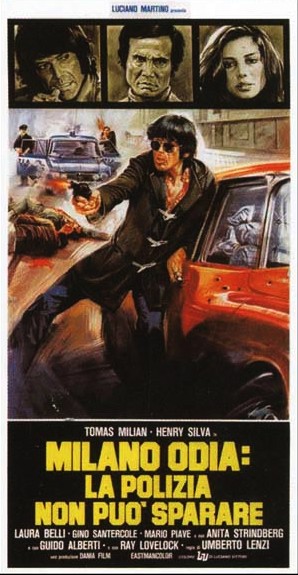 You always like to have strict control over your actors with strong direction. What was it like to work with someone like Tomas Milian?
You always like to have strict control over your actors with strong direction. What was it like to work with someone like Tomas Milian?
Look – I had a few actors that were difficult to direct. The first one was Jack Palance – he was very strong. There are some actors that are more difficult to direct, but Tomas Milian was the most difficult because (goes silent) you know, he was not Italian but Cuban, and when he was young his father killed himself. He has a complex, but he is very talented. I shot with him seven movies – in Roma a Mano Armata and La Banda del Gobbo, to get into character he used a lot of whisky. It’s not a mystery because Tomas talks about it in interviews. During the most important scene in Milano Odia – Almost Human when he is firing the gun…
The scene with the chandelier?
Exactly – he was very drunk. He had one, two, three glasses of whisky and four, five Optalidon before we started shooting. And he gave some whisky to the young boy – Ray Lovelock, he was very young. And Lovelock too, very drunk and it was a big scene. For Tomas it was necessary because it looked better. He said “Look Umberto – Giulio Sacchi is too much. I need … with my sincerity in other case I can’t do the scene well.”
Did he improvise a lot on the set?
No – only the dialogue, he changed the dialogue many times. I was really mad, but afterwards I understood. He was kind – because to make some lines against the society, the students – it was very important for the realism – against the system, the institutional system.
You made a lot of films with Tomas Milian.
Yes – Milano Odia, Roma a Mano Armata, Giustiziere Sfida la Città…
…The Cynic, the Rat and the Fist with Maurizio Merli, Tomas Milian and John Saxon…
It was difficult. After the big success of Roma a Mano Armata the producer wanted another movie and we had the same problem like the American director after me had with the movie with Robert de Niro and Al Pacino – you know, they meet only one scene in the bar.
Heat?
If you look at the movie you see they’re only together for one scene – and at the end of the movie, when De Niro sees Pacino – they shot it seperate. I did the same in Il Cinico, because they meet only in the last scene. I shoot one day with Milian, one day with Merli, and one day with Saxon.
For one car chase in Milano Odia – the one with the white Alfa crashing through burning boxes – you used material that was earlier seen in Sergio Martino’s Milano Trema and afterwards it turned up in your Roma a Mano Armata as well – can you tell some more about this?
The crashes were realised by French stunt coordinator Rémy Julienne and used for the three movies produced by Dania film.
What was Maurizio Merli like? Compared to Tomas Milian he seems like a totally different actor to work with.
Yes – Milian is an actor, but Maurizio is an actor – American style. He can do action without stuntmen, but he was not an ‘internal’ actor, he can not do an internal, psychological way of acting. (goes quiet) He died so young. I’m very sorry.
He started acting in the sixties, but it took him until the seventies to become popular in your movies. Why do you think it took so long?
The movies in the sixties were adventure movies…it was different. Action and spy movies. In the sixties we had westerns.
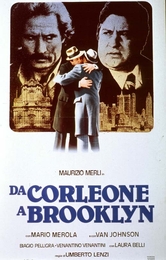 Can you talk some more about working with Maurizio Merli?
Can you talk some more about working with Maurizio Merli?
He was a very good worker – a good guy… Only at the end, when I shot the last one – Da Corleone a Brooklyn – for me it’s one of my best movies, and my last poliziottesco – he was a (sarcastic) ‘star’ – he considered himself a star in the States, in New York.
You can see in the scenes when he’s just exiting the airport – he seems very excited to be there. Was this shot when you actually arrived at the airport?
Yes – because we started at Palermo in the summer. It was January in New York – when we arrived it was twenty degrees lower. It was very hard to shoot the scenes because of the ice. We have a scene in the movie – when Pellegra and Merli are fighting. You remember? At the end of the movie Pellegra jumps from the house and Merli arrives to take him with the bracelets. And after come five or six bad guys and they beat Maurizio.
Yes – while he is standing handcuffed in front of a fence.
It was real – they were no stuntmen, they were men that work as porters in New York. My assistant-director says – “I go to a bar and look for some strange men.” (laughs) And we take them to Maurizio and I shoot it – only one take. I told them, “Go – don’t worry” – and say “Action !” – poor Maurizio. (laughs) He goes down into the snow and I say “Stop !”. He was a very good actor – a good boy.
Why do you consider Da Corleone to Brooklyn to be one of your best polizieschi?
Because it’s a movie about the mafia and it has no happy end.
Why did you have this ending – was there supposed to be a sequel?
The same. I also like it because it is a movie on progress – on the road. We start in Palermo – we go to Rome and New York and the mafia follow to kill Pellegra.
The policeman character is different from the usual role Maurizio Merli plays in your films – he plays by the book.
It’s different. It’s the movie I like the most – the best movie for me.
What do you consider to be your personal trait – what makes a Lenzi movie a Lenzi movie?
The rhythm, the fast editing.
Thank you for your time, mister Lenzi.
Thanks to the organisation of the 26th Brussels International Fantastic Film Festival 2008 for having made this interview possible.
Visit Brussels International Fantastic Film Festival 2008
